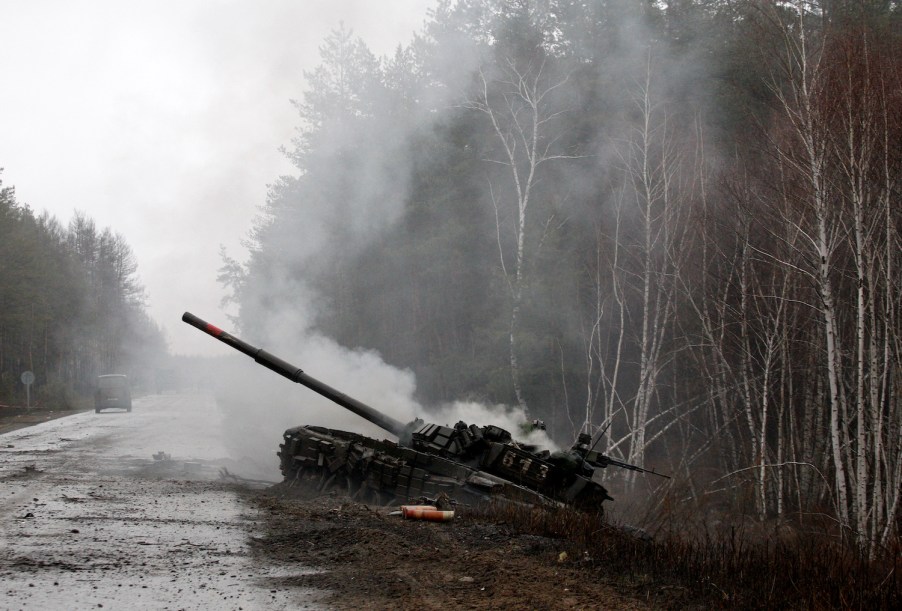
A Critical Design Flaw Is Causing Russian Tanks To Explode
Russia’s invasion of Ukraine is highlighting a critical weakness of the ubiquitous T-72 diesel tank. Ukrainian forces have discovered how to trigger an explosion inside this Russian tank so powerful, that it often blows the tank’s turret clean off. Here is how they are doing it.
The Russian T-72 tank has a critical weakness

The Russian military has been building its T-72 tank since 1969. Over the past fifty years, Russia has built an estimated 25,000 T-72 tanks. Fourty countries import the T-72 for use in their own militaries.
Incremental improvements to the T-72 have included turret armor upgrades and a modern laser rangefinder. But its general design and layout have remained the same since 1969. And this layout includes a critical weakness.
The T-72 houses an armored container for spare ammunition, directly beneath the gunner, called “the carousel.” In addition, it has space for extra ammunition in the turret itself. A direct hit between the tank and its turret with an anti-tank weapon can actually burn through the turret seal and ignite any spare ammunition stored in the turret.
When some of the T-72’s ammunition begins to combust inside the tank, it can cause a chain reaction. If burning ammunition in the turret lights the ammunition in the carousel, the resulting explosion is tremendous. When all the ammunition in a T-72 ignites at once, the pressure of the explosion is often enough to blow the entire turret off the body of the tank and send it flying into the air. This has been nicknamed the jack-in-the-box effect.
Why is the Russian T-72 tank susceptible to anti-tank weapons?

Engineering a tank requires a series of trade-offs. Russian tank designers chose to store the T-72’s main gun ammunition in the body of the tank to keep the vehicle as low–and thus as hard to target–as possible. But this means that when the tank does get hit, it can explode.
When the United States engineered its M1 Abrams tank, it chose to incorporate an armored ammunition compartment into the turret. In the case of a direct hit igniting the Abrams’ spare ammunition, this compartment is designed to explode away from the crew. But as a result, the M1 Abrams is much taller–and thus an easier target–than Russia’s T-72.
Russia’s strategy in Ukraine may be leaving its tanks vulnerable

Dated Russian tanks are susceptible to modern anti-tank weapons. In addition, Russia’s strategy during its invasion of Ukraine has left its tanks vulnerable to attack. The Russian army has used tanks in convoys, along surface roads, while attacking Kyiv.
Jeffrey Edmonds (U.S. military analyst and expert on Russia) warned the Wall Street Journal, “You don’t just drive tanks down roads in columns when there’s a threat of anti-tank missiles, or mines, or things of that nature.”
Despite the Ukrainian military possessing many shoulder-mounted high-powered missiles, the Russian army attempted to drive hundreds of T-72 tanks into Kyiv, through urban centers. The results were disastrous. The Ukrainian army has destroyed at least 440 Russian tanks, at least 225 of them T-72s. Today, the carcasses of exploded T-72s with their turrets blown off, line the roads of Ukraine.
See the Wall Street Journal’s investigation into T-72 exploosions in the video below:



